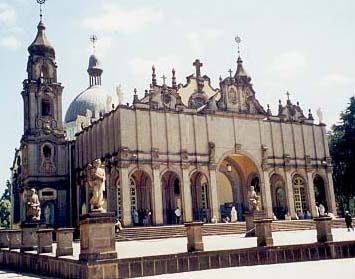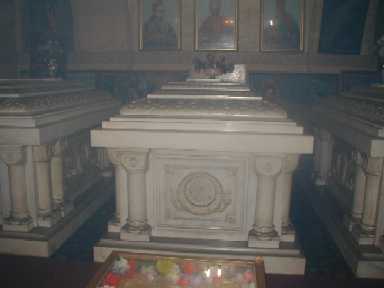In France the Kings were buried at the Abbey of St. Denis north of Paris, in England in Westminster Abbey and later at St. George's Chapel at Windsor. The Emperors of Austria had St. Stephens in Vienna, the Czars had the fortress monastery of Sts. Peter and Paul in St. Petersburg, and the Spanish monarchs the Escorial monastery. In Ethiopia however, there was no single pantheon to deposit the remains of Emperors. Generally, their bodies were buried at various churches that they had built or endowed in their lifetimes. Several Emperor's were buried at the monastery of Kidus Estifanos (St. Stephen) on the island of Daga in Lake Tana. Visitors to Daga Estifanos today are able to view the glass coffins of several Emperors including Tewodros I, Susenyous, Fasiledes and others. Empress Mentewab may have intended her favored monastery of Qusquam Mariam (St. Mary of Qusquam)to be a pantheon of sorts for the Gondar Emperors. She is buried there with her son Emperor Eyasu II, and her grandson Emperor Eyoas I, both the victims of murder. Following the destruction of the Church by the Mahdists in the late 1800's, and the bombing during the Italo-Ethiopian conflict of 1936-41, the church was rebuilt, and the bones of the three monarchs placed in a single glass topped coffin that can be viewed by visitors to the crypt of the church. In 1917, Empress Zewditu built the Masoleum church of Ba'eta Le Mariam(which is named for the feast of the Presentation of the Virgin Mary into the Holy Temple)to house the remains of her late father, Emperor Menelik II. Menelik's widow, Empress Taitu was first buried at Entoto Mariam, but was moved to Ba'eta upon the completion of that church. Empress Zewditu herself would be buried there upon her death in 1930. The church was given the title "Taeka Negest" or Resting Place of Kings. Emperor Haile Selassie built Holy Trinity Cathedral, and several tombs in the crypt below the church. His wife and children were buried in these crypt tombs. Later, he had his own tomb built in the north trancept of the nave of the Cathedral itself, and a matching one for his wife next to his own. His intention was to move the remains of the Empress into this new tomb, and be buried at her side upon his own death. However, due to the revolution of 1974, her remains were never moved and remained in the crypt with those of her children. When the Emperor died in 1975, the victim of regicide, he is said to have been buried upright in a pit over which a latrine was built by the Marxist dictator. Following the fall of the Communist regime in 1991, the Emperors remains were disintered and placed temporarily at the Ba'eta Le Mariam Monastery. Following several disputes between the Imperial family and their supporters with the new government over the status of the planed funeral, the funeral was finally held in November 2000. The remains of Empress Menen were first moved into the tomb built for her in the Nave of the Church, and the Emperor was buried next to her a few days later. The remains of the late Emperor-in-Exile, Amha Selassie, were moved into the tomb in the crypt that had just been vacated by the remains of his mother.
Pictures of and Articles on the Funeral of Emperor Haile Selassie
 Menbere Tseba-ot Kidist Selassie Cathedral (Holy Trinity Cathedral)Burial Place of Emperor Haile Selassie and his Family
Menbere Tseba-ot Kidist Selassie Cathedral (Holy Trinity Cathedral)Burial Place of Emperor Haile Selassie and his Family
 Tomb of Emperor Melelik II at Ba-eta Le Mariam MonasteryWith the tombs of his wife Empress Taitu to his right, and his daughter Empress Zewditu to his left
Tomb of Emperor Melelik II at Ba-eta Le Mariam MonasteryWith the tombs of his wife Empress Taitu to his right, and his daughter Empress Zewditu to his left
 Tomb of Emperor Haile Selassie I at Holy Trinity Cathedral
Tomb of Emperor Haile Selassie I at Holy Trinity Cathedral
 Imperial Burial Traditions
Imperial Burial Traditions


 Imperial Burial Traditions
Imperial Burial Traditions

